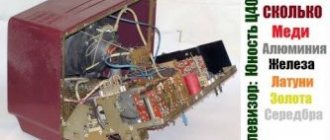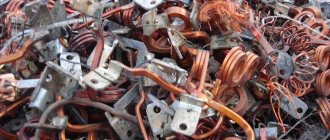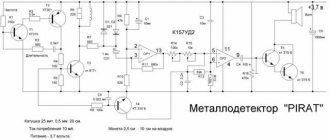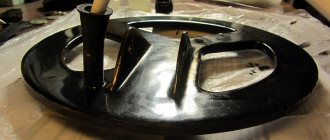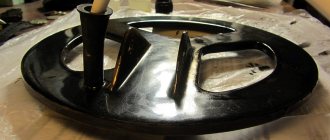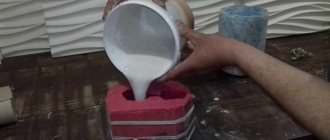Before you start looking for treasures in the surrounding area, you need to study the historical Talmuds. In them you can learn a lot of interesting things about ancient buildings. In the last 100-200 years, dwellings have begun to be built closer to the road with a backyard or garden. In turbulent times of old, the plan was somewhat different. First there was a farmstead behind the fence, and then a house. This was done for the sake of safety, so that enemies and villains could not throw a burning torch to the building. It helped, but not very much.
What to pay attention to
If you still decide to find valuables, and are already looking at one of the abandoned buildings, keep in mind that it may not be the first on this site. In this case, the finds may please you with the range of eras. The problem will be a large accumulation of garbage with metal particles, therefore, a metal detector is not even half the battle. The search must be approached creatively and wisely.
One of the most interesting places in a farmstead or garden are wells. In addition to the fact that small valuables that people drop through carelessness often fall into them, the water in such tanks used to be purified with silver. During the Second World War, all kinds of weapons, ammunition, and other army accessories were often dumped into wells. If the water source has not been cleaned, you can find all sorts of surprises at its bottom, many of which are now in price only due to the statute of limitations. The main thing is to take all safety measures, since the structures are dilapidated and pose a danger to search engines.
Oatmeal-honey pie with glaze: both prepared and eaten very quickly
Delicious lean dessert made from semolina and coconut flakes: no need to even bake
The common people left the city: how the inhabitants of Ancient Rome retained their rights
Where were the treasures hidden?
In order for the treasure hunt to be successful, it is necessary to find out exactly the places where they most often hid their savings in ancient times. First of all, look at your home, no matter how paradoxical it may sound. There are many stories about finding old money, gold and coins in the attic, in the closet, in an abandoned barn and basement, in old chests or hiding places under the floor, especially if your home is more than fifty years old. Perhaps your great-great-grandmothers and great-great-grandfathers tried to hide their wealth using just this method.
Let's return to the topic of old villages. It can be assumed that most often villagers and peasants in the old days buried money in the ground. And so that the loosened earth did not attract attention, and it was dangerous to place the treasure too far away due to the possibility of its loss, they buried jewelry and coins in the yard and vegetable garden. Therefore, you can check such places near abandoned, old-built houses and territories.
More recently, the beginning of the 19th century, during the period of dispossession, it became popular to hide savings in a well. However, searching there, especially if the water intake site is made of wood, is terribly dangerous, you may fail, and there is a risk of the structure collapsing. Therefore, without skill and preparation, and if the place is unreliable, you should not climb there.
Well, the most common places are, of course, beaches, forest glades and other natural areas, but only with a corresponding history.
But still, no matter how much you want to find treasures, avoid disturbing the peace of old graves, mounds and other historical places. Not only can you incur criminal liability for this, there is a high probability of getting yourself into trouble.
Believe the old legend, and perhaps luck will smile on you.
Recommendations
At a dacha or an abandoned site where there is an old well, even one that is regularly cleaned, you can find a treasure in the silt that was taken from the source. Typically, waste was left nearby without taking the time to dispose of it. It is worth noting that previously there were not wells in every area; neighbors went to one source for water. Therefore, it would be a good idea to explore the paths or their intended locations.
It is not difficult to identify them; even on overgrown paths, grass will not grow as actively as on untouched plots. And if the well is still “working”, people absolutely go to it the same way as their ancestors. These paths need to be carefully explored.
At the chosen site for treasure hunting, do not ignore outbuildings or places where they could have been located before. You can identify them by paying attention to the type of vegetation. For example, nettle grows actively in areas rich in humus; elderberry also takes a liking to areas where there is a lot of organic waste. Typically, such sites clearly stand out against the background of the overall plant picture.
Why natural sounds not only lift your mood, but also relieve stress
Kinchev, Garkusha, Stingray and others shared their memories of the rock club
Daughters know who they treat better: the unusual upbringing of a father with many children
How to find a treasure?
How to find a treasure Of course, we can only give a few tips that can significantly help in finding a treasure with coins.
We cannot guarantee you a find. For this, in addition to knowledge, you need luck and luck. We will try to help with knowledge, but you will have to bring everything else with you. Although that's not all. We also need tools and devices with which to search for and dig up treasure. So, how to find coins without a metal detector? Let's start with where to look for them. And really, where? In the city, village, forest? It’s worth saying here that any old, abandoned house can be a great place for treasure. In cities there are few such houses, but in villages there are plenty. Of course, the earth also brings a lot of treasures. These are old cemeteries, mounds, temples and many other places. We are armed only with a shovel, a hatchet, a crowbar and a crowbar. It is advisable to also have a flashlight and a small iron scoop. Let's say that you have in mind an abandoned house in which no one lives.
Garden
If there is a garden on the territory, it also needs to be given close attention. Here you need to identify the oldest trees, under which it is quite possible to find something useful or valuable. An important point - if you are lucky and the treasure is really buried under a tree, you should not expect to extract it “in one fell swoop”. As a rule, the roots grow, pulling away things and objects around them. You should carefully and thoughtfully walk around the plant several times, not forgetting about the little things.
You should also take a look around the rest of the garden. The trees themselves may no longer exist, but this does not mean that it has always been this way. Try to find stumps or their remains, this will be at least some kind of landmark.
Finding coins without a metal detector
Searching for treasures and ancient coins is an exciting activity, but often requires special equipment. However, even without expensive metal detectors, every enthusiastic person can organize a search for old coins. Naturally, there won’t be many finds, but there will definitely be some. I suggest looking for “treasures” in abandoned old houses and adjacent areas. I also started doing amateur searches without equipment, so I have some experience in this matter (I searched in two villages of the Shadrinsky district).First of all, make sure that the abandoned house is really no one's. As a rule, the windows there are broken, the floors may have already been removed, and the entrance doors are open. You will still need some tools: a sharp hatchet, two pullers - a large and a small one, and a children's metal scoop. You should also determine the approximate age of the house. This can be done, for example, on the foundation. A really old house should be built on stones, millstones, or, if large, on a brick foundation. Logs should only be placed on moss. It makes sense to look at whether the house has been rebuilt (presence of an additional extension, pouring of the foundation, type of window and door units).
Basic coin stashes and hiding places were usually made during the construction of a house. There are several places that you should definitely check out. These are the spaces between window and door blocks and walls (sidewalls, window sills and thresholds), the joints of mother logs and walls. If you're lucky, you can find a handful of silver, but you'll have to work hard with an ax (a suitable chainsaw in this case will create unnecessary noise) and a plucker. I recommend these places because I myself found coins there. You can check the logs under the removed window sills for hiding places. Knowledgeable people said that, although it is rare, you can find a worthy treasure there - someone’s stash.
When removing door and window frames, as well as when removing logs from grooves, try to carefully look through the moss. Small coins can simply be shaken off casually. It is the space between the window frames - the internal platbands - that is the “century-old piggy bank”. Over a hundred years, a lot of small nonsense accumulates there, including coins and old buttons. Personally, I really enjoy opening window frames and sills. Often, along with royal change, you can find early and late Soviet coins, badges and metal buttons there.
Another promising, and most importantly, 100% place in an old house is the ground under the floors. Naturally, the floors themselves should no longer exist (villagers from an abandoned house drag away thick floorboards first). This is where a children's metal scoop will come in handy. Your task will be to carefully dig up the top layer. Over the years, dozens of coins may have fallen through the floorboards. Very often you come across Soviet small items. But we need to see if the cellar was dug recently, since when digging, the earth was not pulled out, but spread along the walls.
The next possible place to store coins is in the corners of the house. There is no general rule to follow when putting coins in the corners of the house, so it is best to gut all four corners. Of course, you may not find anything (not every owner could be generous), but if you find it, the coins should be respectable - very large. I haven’t found anything in the corners below three-kopek coins; I often come across coins from Nicholas II. It is not always possible to crack a corner, so it is better to immediately assess your strength and the safety of the logs.
You can try to dig up the rubble, which usually consists of many layers - iron, humus, sand, straw. There is almost no chance of finding a secret place there, but you can find some ancient objects - an iron, a saber, spoons, etc. In addition to this article, another useful article is finding coins in attics.
Garden
The principle of searching for treasure on a personal plot is identical to conducting research in the field. However, there are several nuances. First of all, you should pay attention to the boundary path. Usually, next to it or in the path itself, you come across quite interesting finds, well preserved.
Vertical flower bed made of PET bottles: a great idea for a small summer cottage
Andrei Ilyin said that Yakovleva’s son was wildly jealous of his mother’s on-screen husband
We need to praise dads for staying at home with their children, but we shouldn’t forget about moms either
If trees grow along the garden, they need to be carefully examined, especially the ground near the roots. Previously, workers rested and had a snack under them, often leaving tableware and other small items. Even though these are not diamonds, their value is quite high, both in a historical and material sense.
Where should I send what I find?
At first glance, the most difficult thing seems to be finding gold. But an equally simple task is to find a buyer and properly sell the found gold. At the same time, lose as little money and time as possible.
Ligature scrap and decorations
Handing over scrap gold in Russia is not a problem; in any city there are pawn shops that accept gold from the population. To successfully return the found jewelry, you will need an ID card.
If the found jewelry is still valuable as a product or historical object, you can find a buyer for it who will take it for more than scrap.
Pure metal
Many private miners are in a hurry to get money for nuggets and sell gold to the owner of the enterprise, which previously selected the main gold from the site, at a price of 1500-2000 rubles per gram.
This is extremely unprofitable for a private gold miner. After all, this is the price of buying scrap gold alloyed (broken chains, bracelets, earrings, etc.), and not pure gold.
Even the popular
585 , from which jewelry is made, contains only 58.5% pure precious metal.
One can imagine how much money a private miner loses after spending a lot of time and effort searching for pure gold and selling it at the price of scrap gold.
The same applies to refined gold extracted from radio components and devices.
To profitably sell pure gold, you need to know this:
- The market value of gold at the time of sale.
- The price will be affected by the beautiful appearance of the nuggets. They are often bought by collectors for whom this is important. The highest prices will be paid for pure nuggets without foreign inclusions. Collectors buy beautiful, bright nuggets at a price above the market price.
- The cost of a nugget also depends on the place where it was found . This is an important point for collectors. They will pay more for something found in a little-known deposit.
- Pawn shops , buying ─ this is not the best way to sell gold nuggets; in the best case scenario, only half of their real value will be paid for them. Handing over gold to a refinery, where it is purified from impurities ─ also means losing 20% of its value.
- You can't rush to sell. We must calmly and carefully search for the right buyer, be it a collector or a reseller.
Local area
This stage is one of the most difficult and time-consuming. If you need a decent result, you need to show perseverance, consistency and endurance. If you are a real treasure hunter, put aside squeamishness and reasoning such as that there can be nothing valuable in this trash can. Walking past unsightly waste, you may simply not notice the treasure.
A friend of mine shared his personal experience. On one of his hikes, he came across marks in the ground, indicating that fires had been made there for hundreds of years, they had been used for waste, and there were no buildings or trees. Nevertheless, under one spot he discovered nickels from the time of Catherine II. The next time, in a similar situation, a silver royal “fifty kopeck” was found.
Many people do not believe that even without a modern metal detector it is possible to find anything valuable in abandoned areas. As practice shows, a person just needs to seriously set a goal, and after the first success he cannot be stopped. Even if you don’t manage to become a millionaire, historical finds and artifacts will bring not only material, but also moral satisfaction.
Found a violation? Report content
Amateur treasure hunters
Amateur treasure hunters
Old treasure hunters say that in our business, the main thing is the head, not the metal detector. This is true. After all, the German Schliemann found Troy without using any instruments. In general, history is replete with facts when treasures were found not by professional archaeologists, but by amateur treasure hunters. And these guys never had not only metal detectors, but even decent tools. Of course, they had a certain amount of knowledge and confidence that they would be lucky. As you can see, this was quite enough for them to find the treasure. So what's the deal? It turns out that only self-confidence.
